Research on Dynamic Reserve and Energy Arbitrage of Energy Storage System
Abstract
1. Introduction
2. Proposed Preventive Control Strategy
3. Constraints of Economic Dispatch
3.1. Objective Function
3.2. Diesel Generator
3.3. ESS
3.4. Power Balance Constraint
3.5. Spinning Reserve Constraint
3.6. Ramp Rate Constraint
3.7. PV Curtailment Constraint
3.8. Security Constraints
4. Description and Introduction of Simulation Environment
4.1. System Model and Settings
4.2. Generator ED Model
4.3. Selection of Diesel Generator Model in PSS®E
4.4. ESS’s Response in Trip Contingency
4.4.1. ESS1(Frequency Regulation)
4.4.2. ESS 2 and ESS 3 (Energy Arbitrage)
5. Simulation Results
5.1. Case 1: Multi-Function ESS (Proposed Method)
5.2. Case 2: ESS Functioning as a Frequency Support
6. Discussion
7. Conclusions
Author Contributions
Funding
Institutional Review Board Statement
Informed Consent Statement
Data Availability Statement
Conflicts of Interest
Appendix A
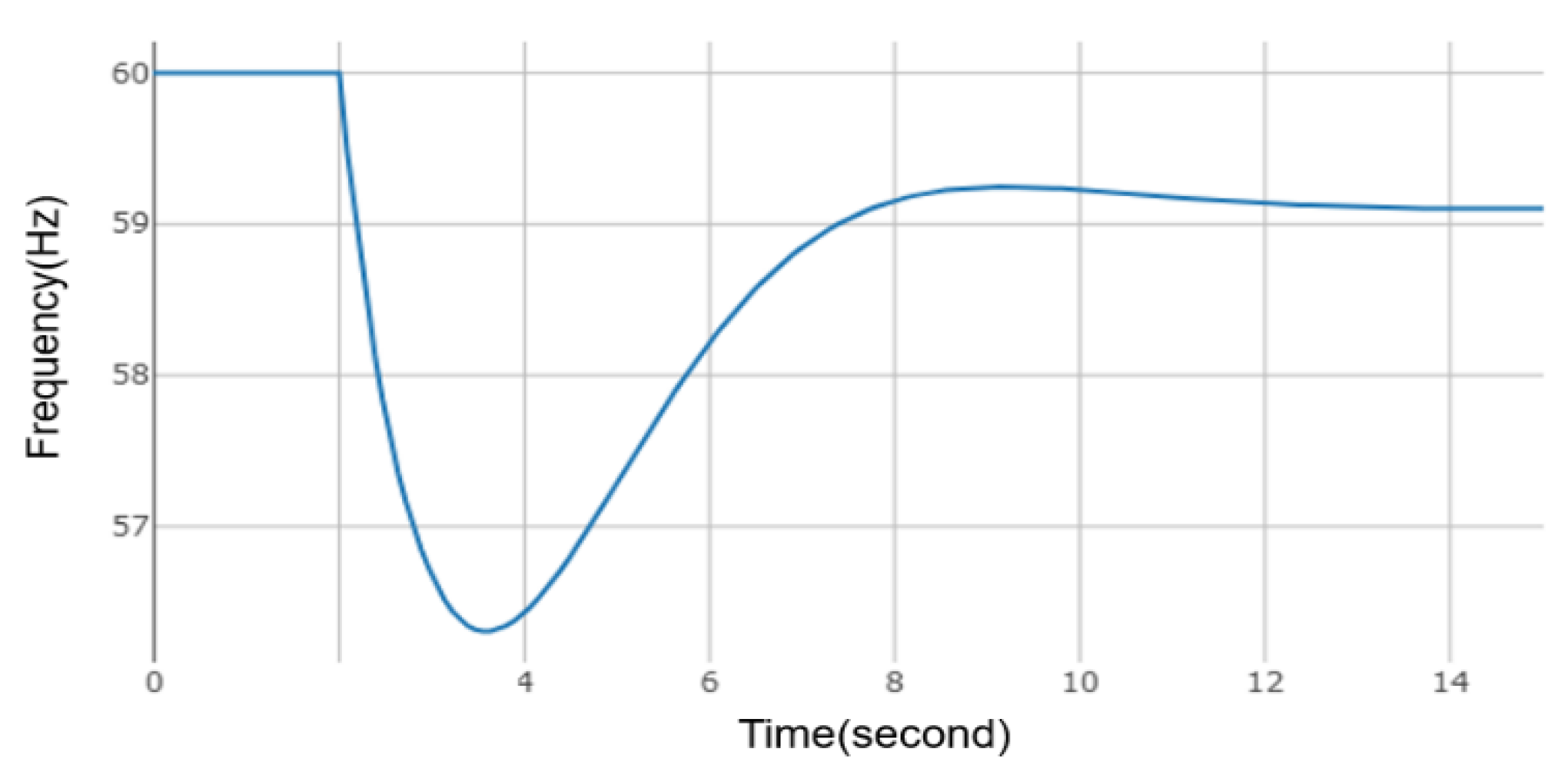
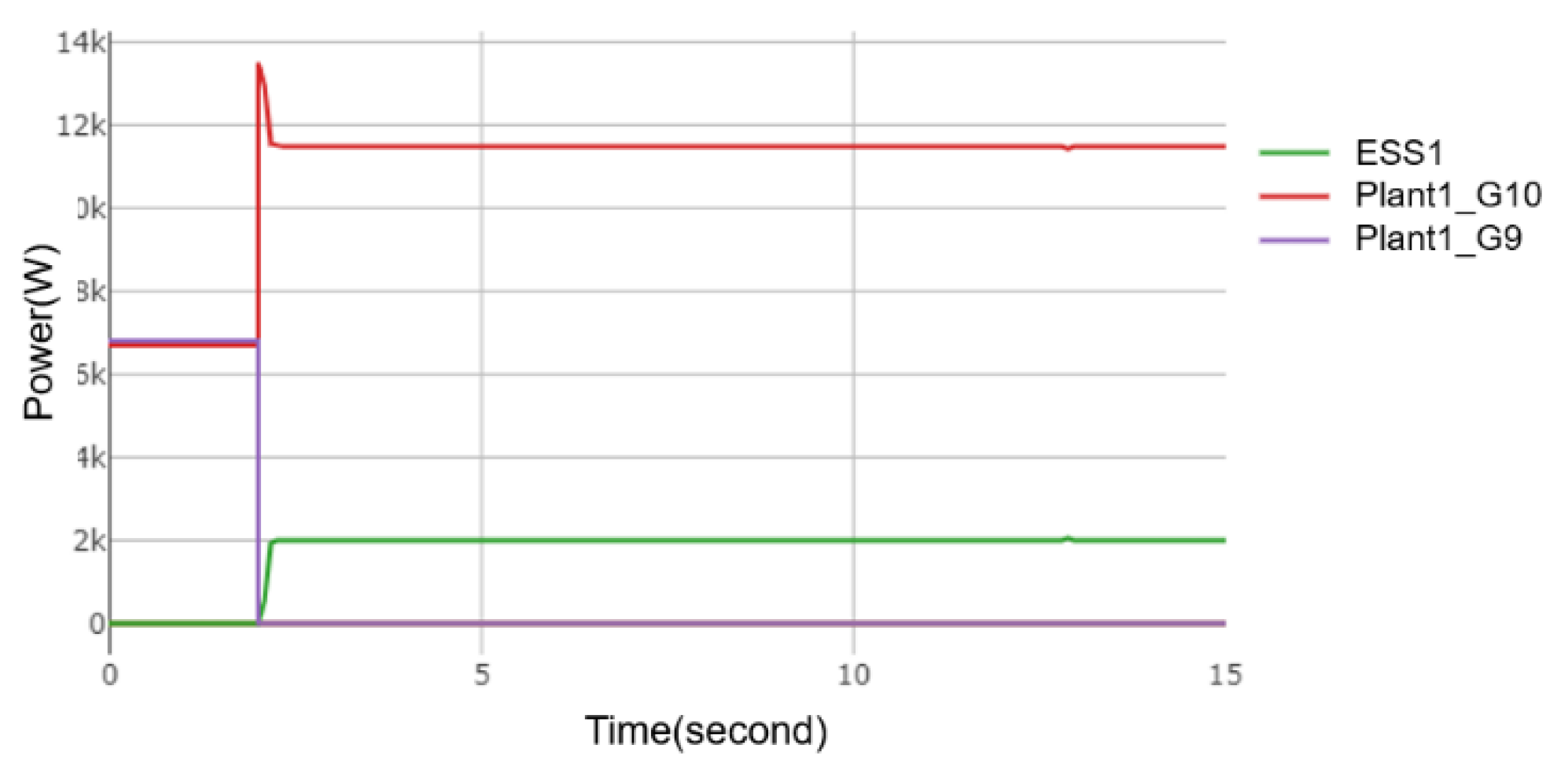
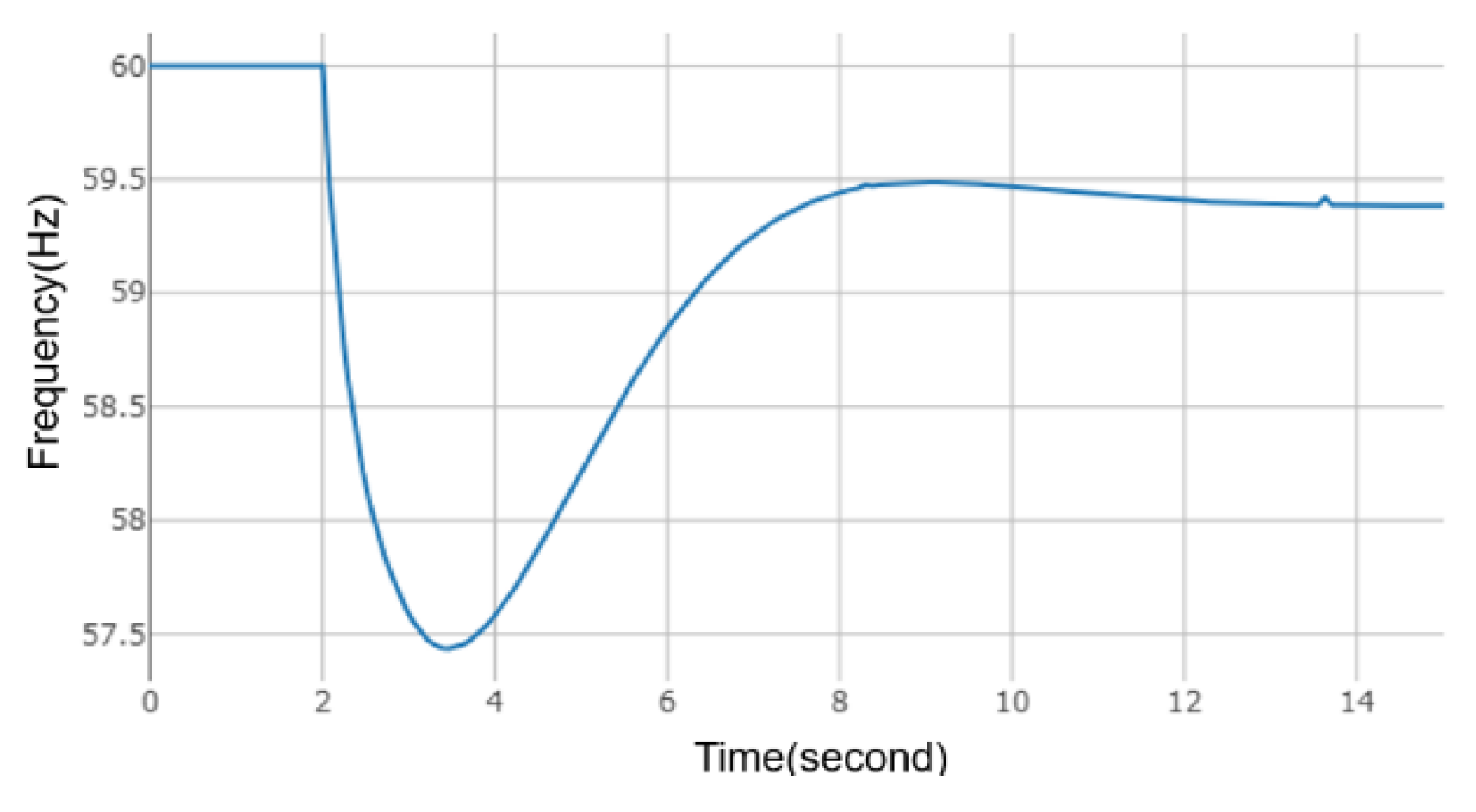

References
- Kundur, P.; Balu, N.J.; Lauby, M.G. Power System Stability and Control; McGraw-Hill Education: New York, NY, USA, 1994. [Google Scholar]
- Ela, E.; Milligan, M.; Kirby, B. Operating Reserves and Variable Generation; National Renewable Energy Laboratory: Berkeley, CA, USA, 2011. [Google Scholar]
- Yan, R.; Saha, T.K.; Modi, N.; Masood, N.-A.; Mosadeghy, M. The combined effects of high penetration of wind and PV on power system frequency response. Appl. Energy 2015, 145, 320–330. [Google Scholar] [CrossRef]
- Fernández-Guillamón, A.; Gómez-Lázaro, E.; Muljadi, E.; Molina-García, Á. Power systems with high renewable energy sources: A review of inertia and frequency control strategies over time. Renew. Sustain. Energy Rev. 2019, 115, 109369. [Google Scholar] [CrossRef]
- Yang, J.-S.; Liao, C.-J.; Wang, Y.-F.; Chu, C.-C.; Lee, S.-H.; Lin, Y.-J. Design and Deployment of Special Protection System for Kinmen Power System in Taiwan. IEEE Trans. Ind. Appl. 2017, 53, 4176–4185. [Google Scholar] [CrossRef]
- Kuo, M.-T.; Lu, S. Experimental Research and Control Strategy of Pumped Storage Units Dispatching in the Taiwan Power System Considering Transmission Line Limits. Energies 2013, 6, 3224–3244. [Google Scholar] [CrossRef]
- Shekari, T.; Aminifar, F.; Sanaye-Pasand, M. An Analytical Adaptive Load Shedding Scheme Against Severe Combinational Disturbances. IEEE Trans. Power Syst. 2016, 31, 4135–4143. [Google Scholar] [CrossRef]
- Akram, U.; Mithulananthan, N.; Shah, R.; Basit, S.A. Energy Storage for Short-Term Frequency Stability Enhancement in Low-Inertia Power Systems. In Proceedings of the 2020 Australasian Universities Power Engineering Conference (AUPEC), Hobart, Australia, 29 November–2 December 2020. [Google Scholar]
- Das, C.K.; Mahmoud, T.S.; Bass, O.; Muyeen, S.; Kothapalli, G.; Baniasadi, A.; Mousavi, N. Optimal sizing of a utility-scale energy storage system in transmission networks to improve frequency response. J. Energy Storage 2020, 29, 101315. [Google Scholar] [CrossRef]
- Ramírez, M.; Castellanos, R.; Calderón, G.; Malik, O. Placement and sizing of battery energy storage for primary frequency control in an isolated section of the Mexican power system. Electr. Power Syst. Res. 2018, 160, 142–150. [Google Scholar] [CrossRef]
- Zhao, H.; Wu, Q.; Huang, S.; Guo, Q.; Sun, H.; Xue, Y. Optimal siting and sizing of Energy Storage System for power systems with large-scale wind power integration. In Proceedings of the 2015 IEEE Eindhoven PowerTech, Eindhoven, The Netherlands, 29 June–2 July 2015. [Google Scholar]
- Bera, A.; Abdelmalak, M.; Alzahrani, S.; Benidris, M.; Mitra, J. Sizing of Energy Storage Systems for Grid Inertial Response. In Proceedings of the 2020 IEEE Power & Energy Society General Meeting (PESGM), Montreal, QC, Canada, 2–6 August 2020. [Google Scholar]
- Knap, V.; Chaudhary, S.K.; Stroe, D.-I.; Swierczynski, M.J.; Craciun, B.-I.; Teodorescu, R. Sizing of an Energy Storage System for Grid Inertial Response and Primary Frequency Reserve. IEEE Trans. Power Syst. 2016, 31, 3447–3456. [Google Scholar] [CrossRef]
- Bera, A.; Chalamala, B.R.; Byrne, R.H.; Mitra, J. Sizing of Energy Storage for Grid Inertial Support in Presence of Renewable Energy. IEEE Trans. Power Syst. 2022, 37, 3769–3778. [Google Scholar] [CrossRef]
- Rahman, M.; Oni, A.O.; Gemechu, E.; Kumar, A. Assessment of energy storage technologies: A review. Energy Convers. Manag. 2020, 223, 113295. [Google Scholar] [CrossRef]
- Ross, M.; Abbey, C.; Bouffard, F.; Joos, G. Microgrid Economic Dispatch With Energy Storage Systems. IEEE Trans. Smart Grid 2018, 9, 3039–3047. [Google Scholar] [CrossRef]
- Liu, J.; Sun, X.-Y.; Bo, R.; Wang, S.; Ou, M. Economic dispatch for electricity merchant with energy storage and wind plant: State of charge based decision making considering market impact and uncertainties. J. Energy Storage 2022, 53, 104816. [Google Scholar] [CrossRef]
- Zeng, Y.; Li, C.; Wang, H. Scenario-Set-Based Economic Dispatch of Power System With Wind Power and Energy Storage System. IEEE Access 2020, 8, 109105–109119. [Google Scholar] [CrossRef]
- Zhang, G.; McCalley, J.D.; Wang, Q. An AGC Dynamics-Constrained Economic Dispatch Model. IEEE Trans. Power Syst. 2019, 34, 3931–3940. [Google Scholar] [CrossRef]
- Zhang, G.; Ela, E.; Wang, Q. Market Scheduling and Pricing for Primary and Secondary Frequency Reserve. IEEE Trans. Power Syst. 2019, 34, 2914–2924. [Google Scholar] [CrossRef]
- Chen, Y.-T.; Kuo, C.-C.; Jhan, J.-Z. Research on Energy Storage Optimization Operation Schedule in an Island System. Appl. Sci. 2021, 11, 3690. [Google Scholar] [CrossRef]
- Xu, X.; Elkhatib, M.; Yousefian, R.; Tang, J.; Choi, B.; Huang, L.; Mao, Y.; Berner, A. Automatic N-1–1 System Stability Study of the PJM System. In Proceedings of the 2020 IEEE Power & Energy Society General Meeting (PESGM), Montreal, QC, Canada, 2–6 August 2020. [Google Scholar]
- Xue, N.; Wu, X.; Gumussoy, S.; Muenz, U.; Mesanovic, A.; Heyde, C.; Dong, Z.; Bharati, G.; Chakraborty, S.; Cockcroft, L. Dynamic Security Optimization for N-1 Secure Operation of Hawai‘i Island System With 100% Inverter-Based Resources. In Proceedings of the 2021 IEEE Power & Energy Society General Meeting (PESGM), Virtual, 26–29 July 2021. [Google Scholar]
- Arava, V.N.; Vanfretti, L. Analyzing the Static Security Functions of a Power System Dynamic Security Assessment Toolbox. Int. J. Electr. Power Energy Syst. 2018, 101, 323–330. [Google Scholar] [CrossRef]
- Singh, R.; Elizondo, M.; Lu, S. A review of dynamic generator reduction methods for transient stability studies. In Proceedings of the 2011 IEEE Power and Energy Society General Meeting, Detroit, MI, USA, 24–28 July 2011. [Google Scholar]
- Yang, J.P.; Cheng, G.H.; Xu, Z. Dynamic Reduction of Large Power System in PSS/E. In Proceedings of the 2005 IEEE/PES Transmission & Distribution Conference & Exposition: Asia and Pacific, Dalian, China, 18 August 2005. [Google Scholar]
- Gonzalez-Castellanos, A.; Pozo, D.; Bischi, A. Detailed Li-ion battery characterization model for economic operation. Int. J. Electr. Power Energy Syst. 2020, 116, 105561. [Google Scholar] [CrossRef]
- Schaefer, S.; Vudata, S.P.; Bhattacharyya, D.; Turton, R. Transient modeling and simulation of a nonisothermal sodium–sulfur cell. J. Power Sources 2020, 453, 227849. [Google Scholar] [CrossRef]
- Liao, C.-J.; Hsu, Y.-F.; Wang, Y.-F.; Lee, S.-H.; Lin, Y.-J.; Chu, C.-C. Experiences on Remediation of Special Protection System for Kinmen Power System in Taiwan. IEEE Trans. Ind. Appl. 2020, 56, 2418–2426. [Google Scholar] [CrossRef]
- Ministry of Economic Affairs, R.O.C. 2020. Available online: https://www.moea.gov.tw/Mns/Populace/news/News.aspx?kind=1&menu_id=40&news_id=90470 (accessed on 20 November 2022).

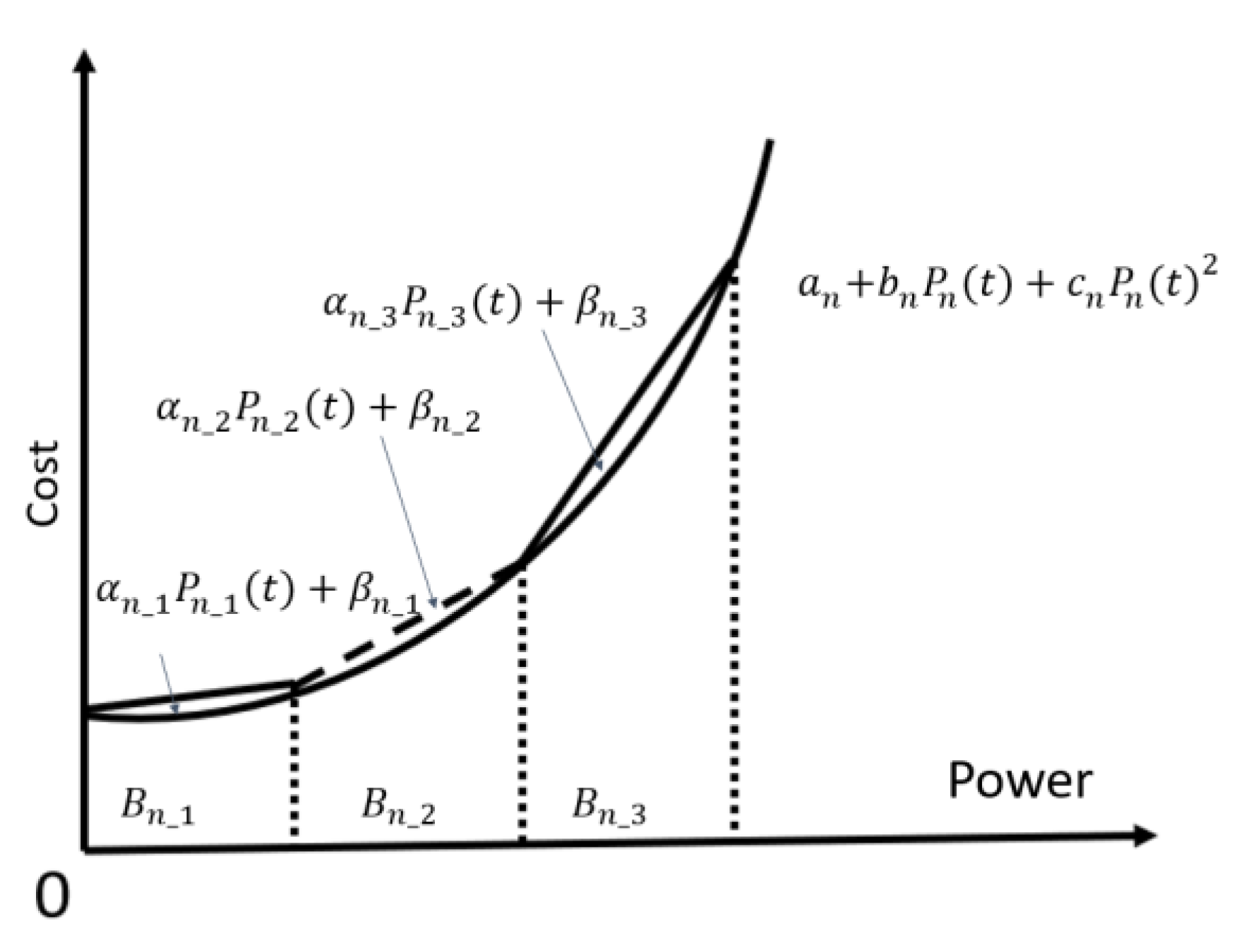
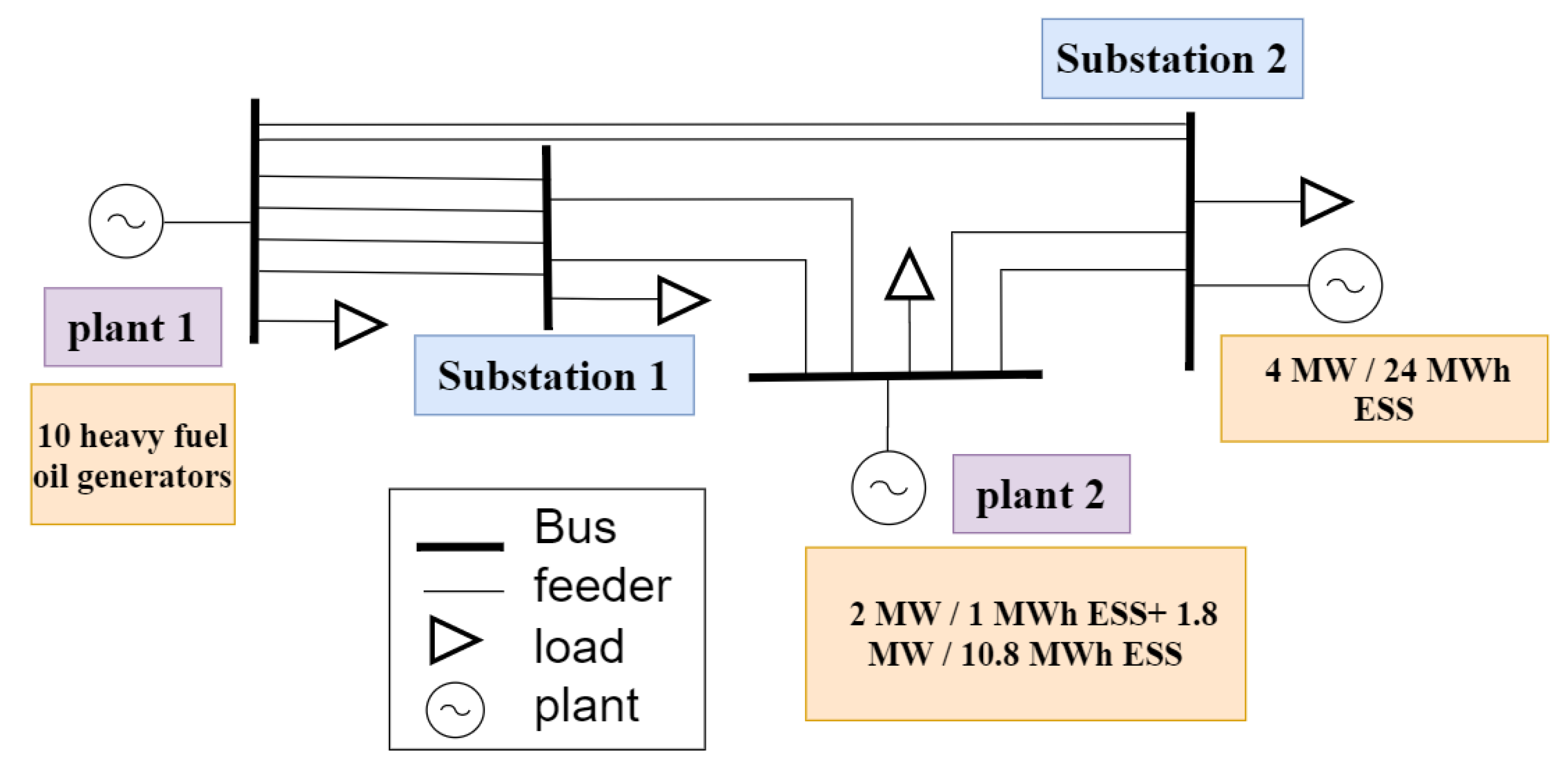
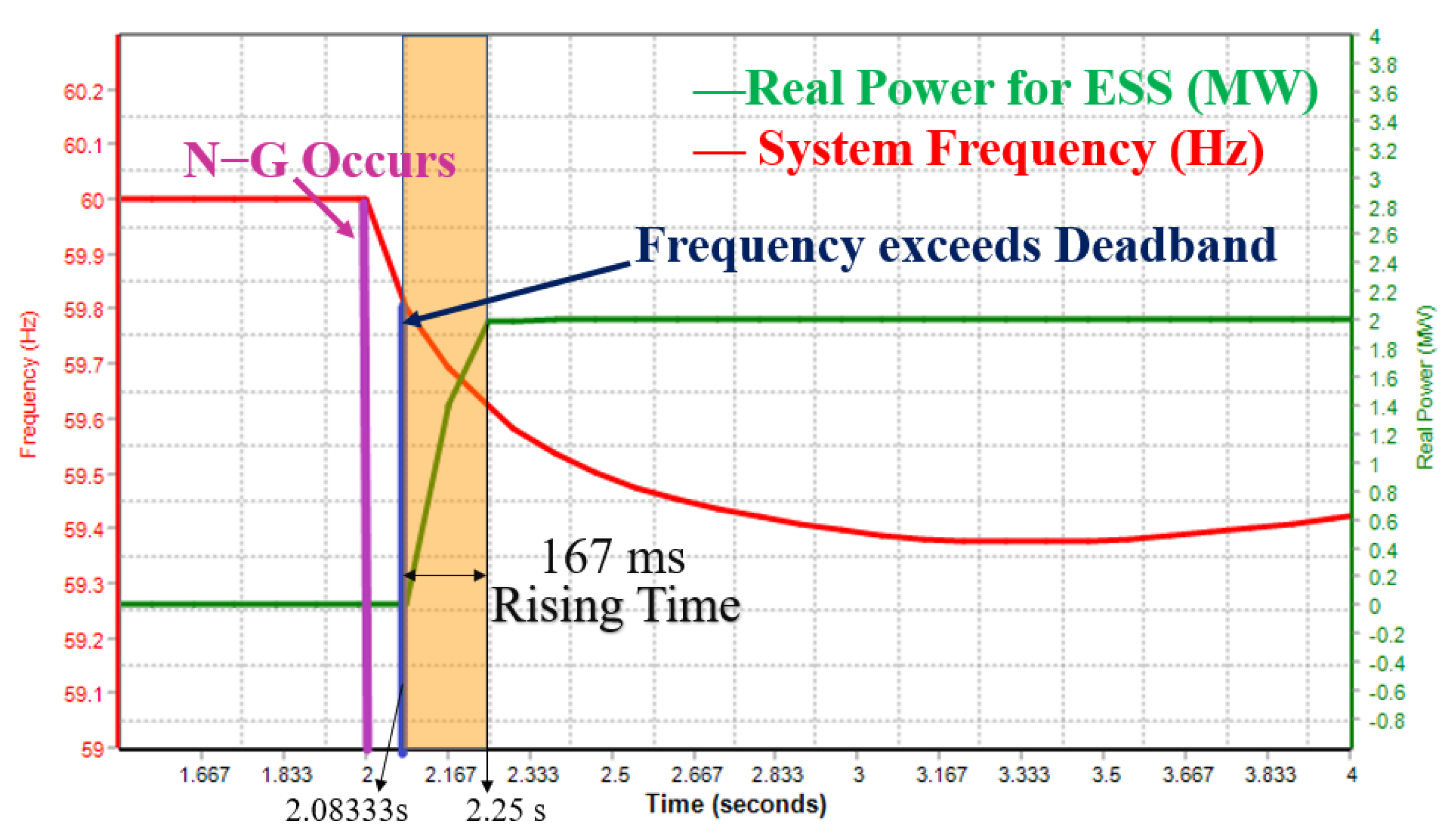
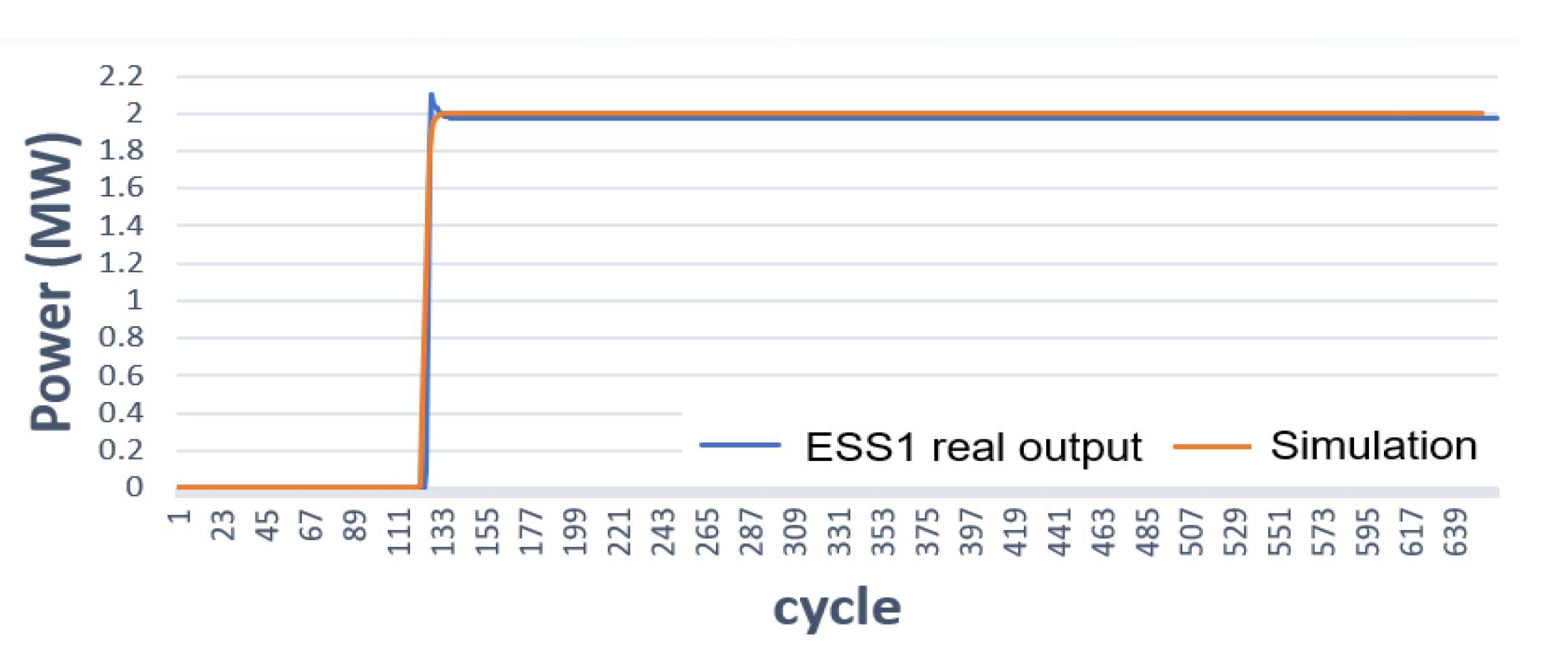
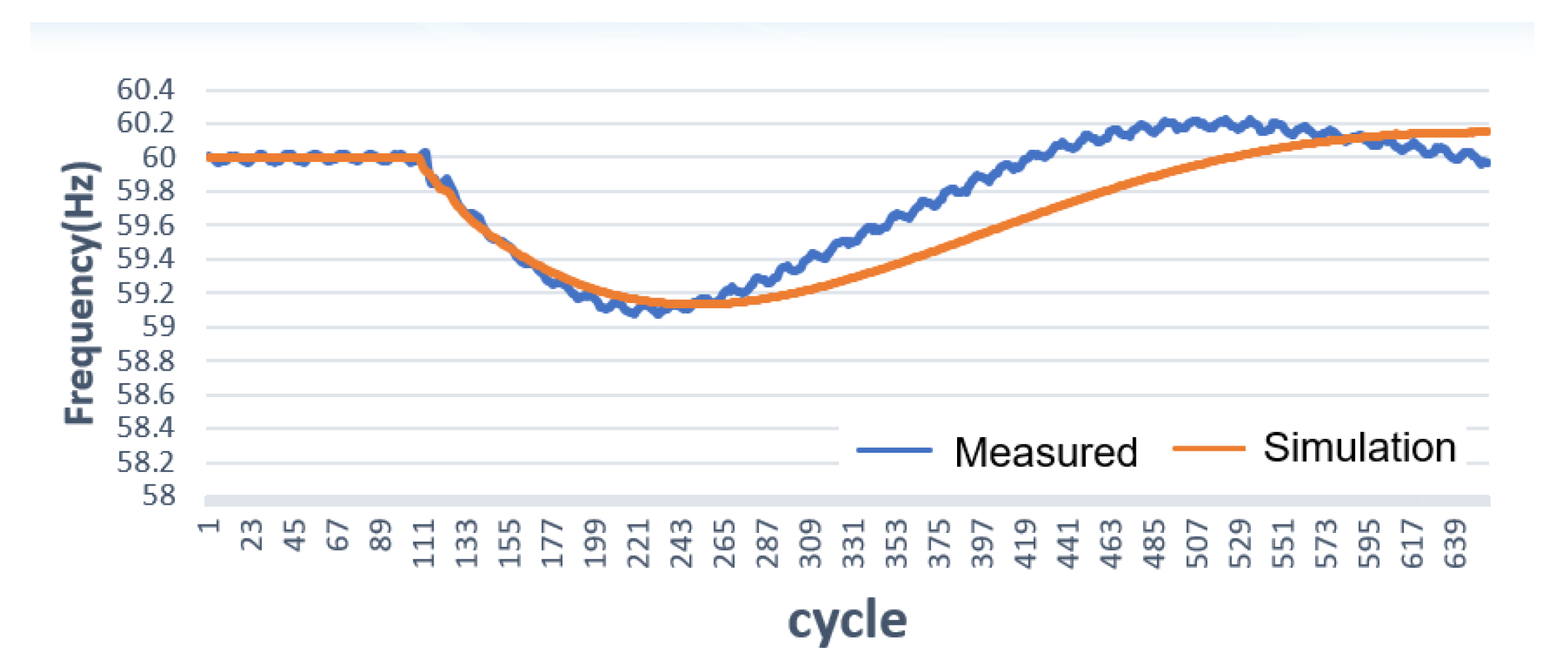
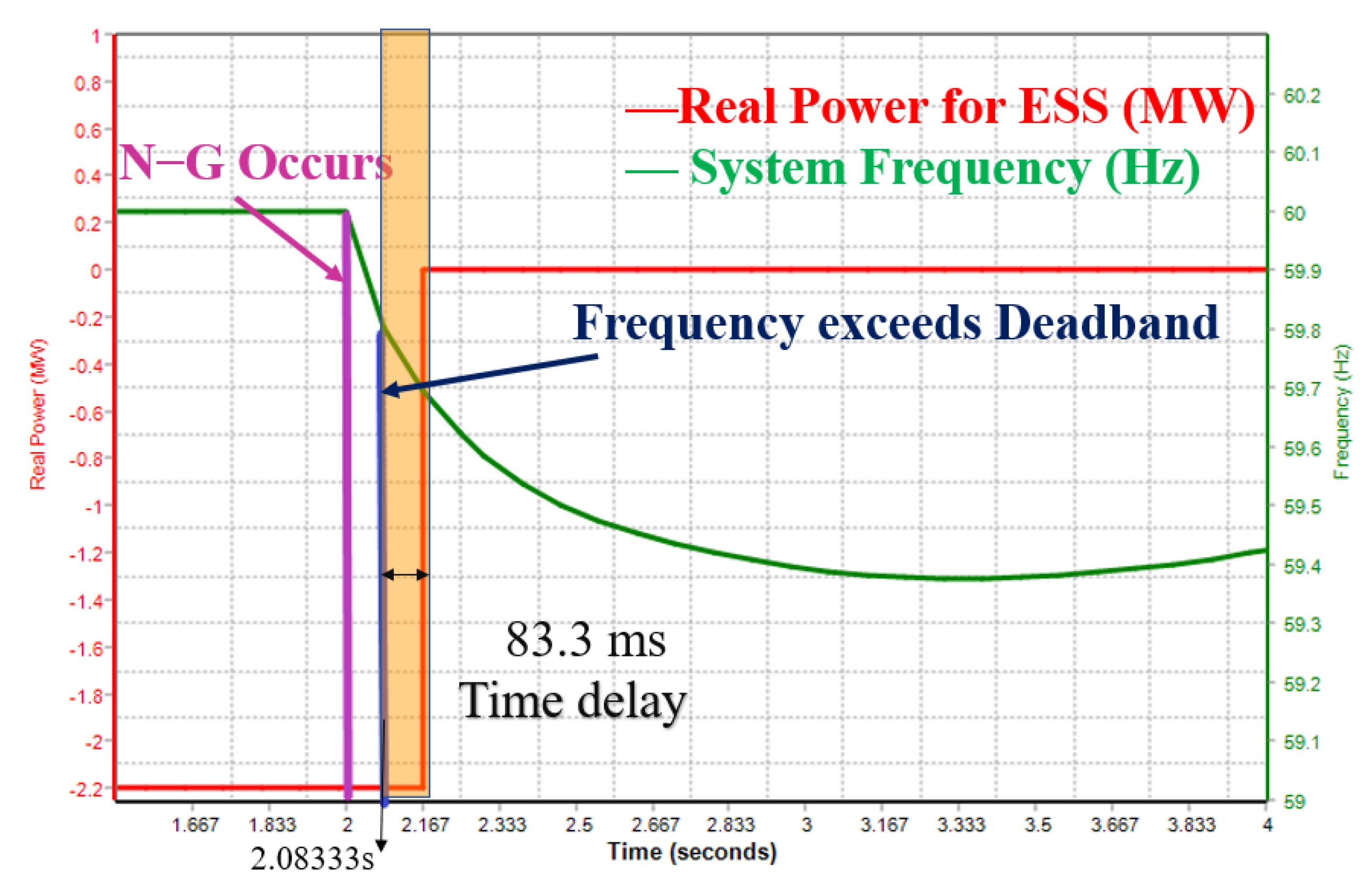

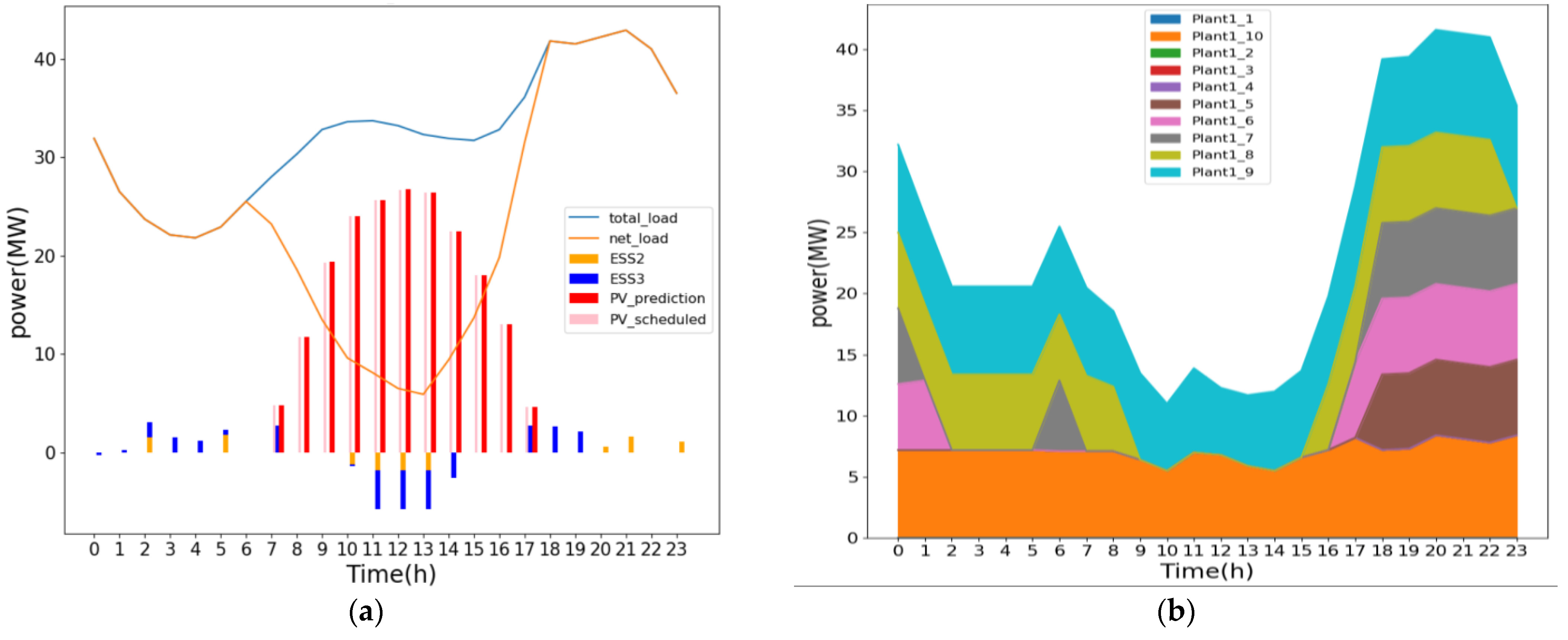

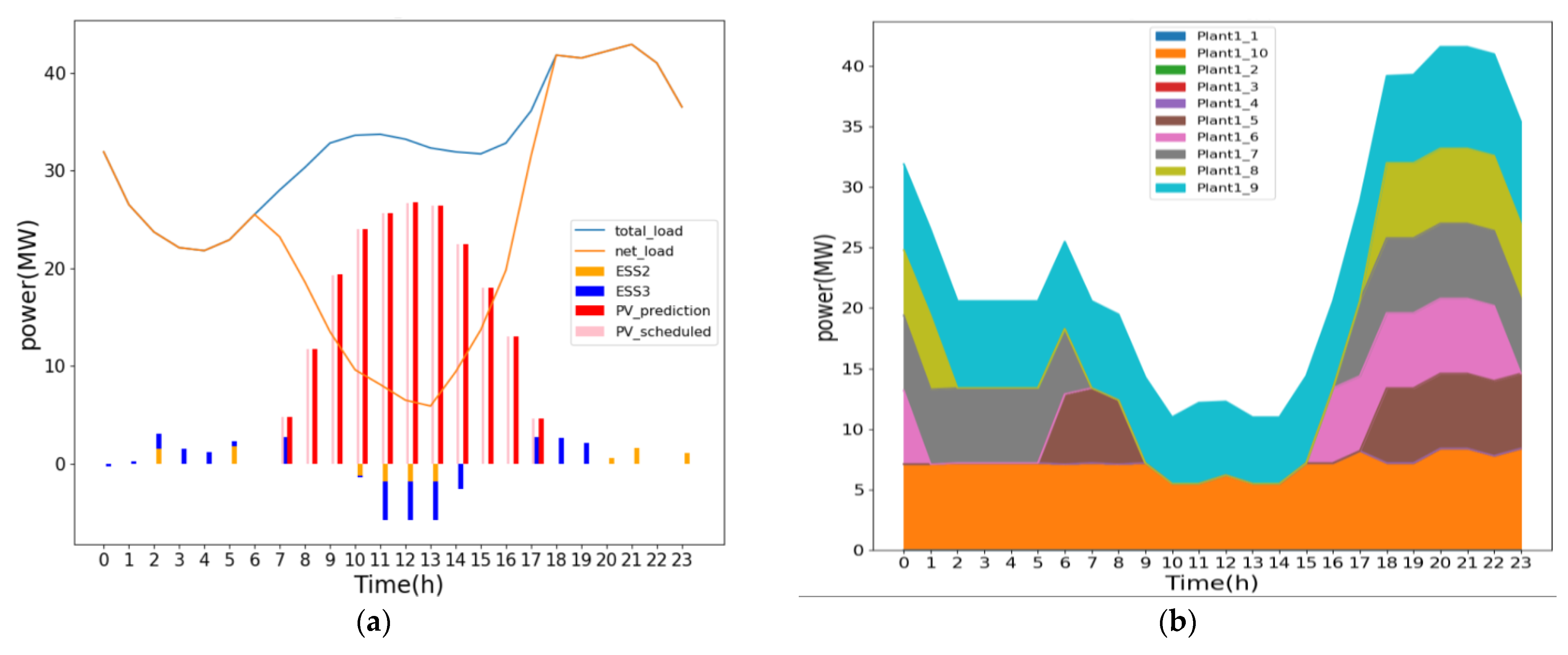
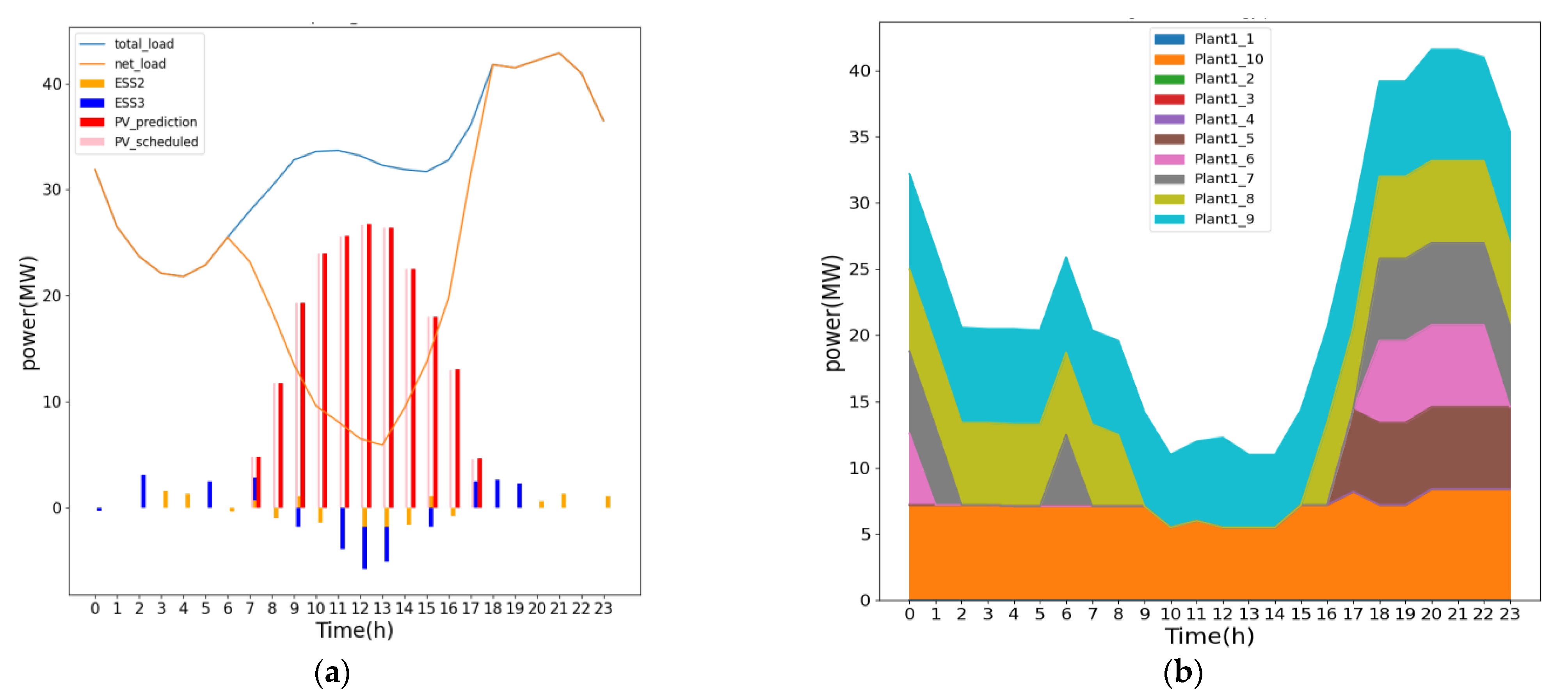

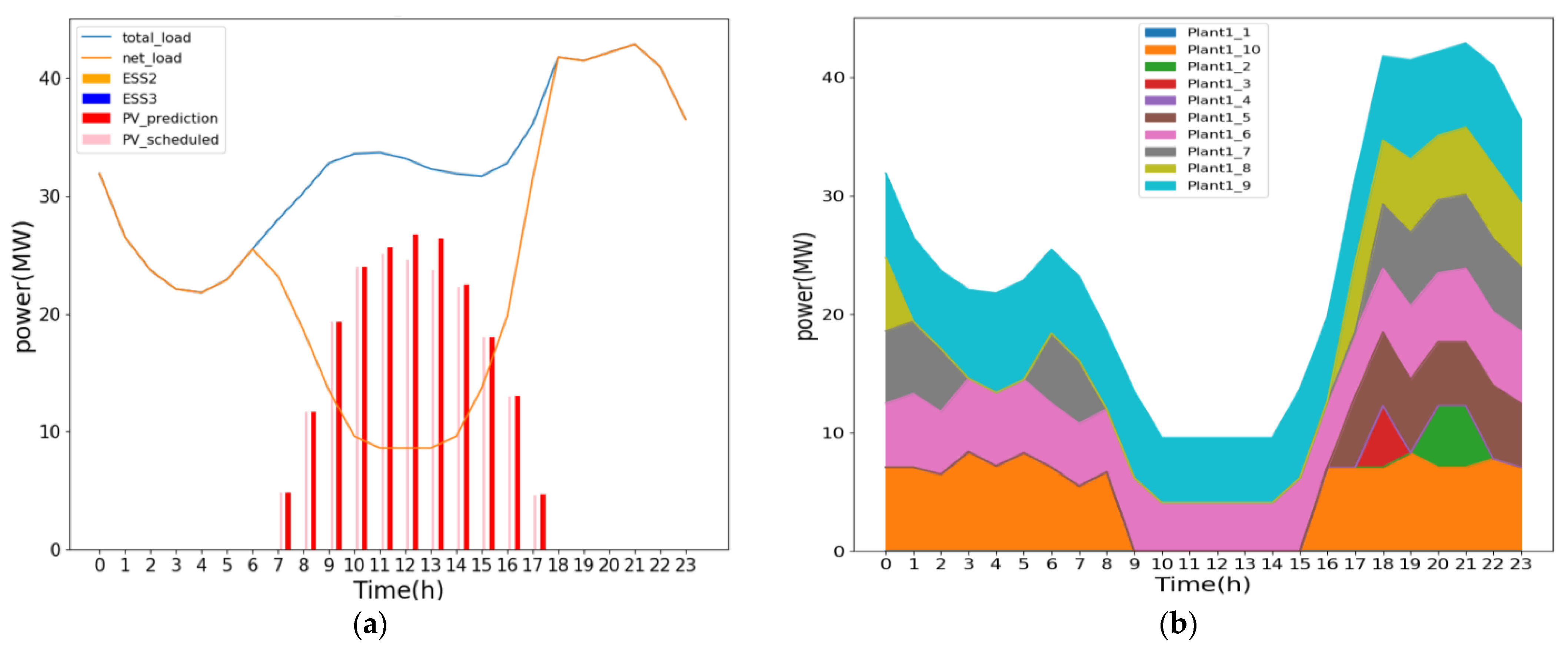
| Type | Specification | Original Function | |||
|---|---|---|---|---|---|
| ESS1 | lithium ion | 2 MW/1 MWh | frequency regulation | x | x |
| ESS2 | sodium-sulfur | 1.8 MW/10.8 MWh | energy arbitrage | 19% | 81% |
| ESS3 | not yet announced | 4 MW/24 MWh | energy arbitrage | 19% | 81% |
| Units | Capacity (MVA) | Minimum Power Generation (MW) | Maximum Power Generation (MW) |
|---|---|---|---|
| Plant1 #1–4 | 10.2 | 4 | 7.7 |
| Plant1 #5–8 | 9.7 | 4.1 | 7.8 |
| Plant1 #9–10 | 13.8 | 5.5 | 10.5 |
| Plant2 #1–6 | 4.36 | 1.5 | 3.488 |
| Units | Start-Up Cost | |||
|---|---|---|---|---|
| Plant1 #1–4 | 15 | 1.9161 | 0.0661 | 7 |
| Plant1 #5–8 | 13 | 1.8518 | 0.0657 | 7 |
| Plant1 #9–10 | 12 | 1.7966 | 0.0615 | 10 |
| Units | Segment 1 | Segment 2 | Segment 3 |
|---|---|---|---|
| Plant1 #1–4 | 2.526x + 13.617 | 2.690x + 12.763 | 2.853x + 11.709 |
| Plant1 #5–8 | 2.471x + 11.564 | 2.634x + 10.699 | 2.796x + 9.635 |
| Plant1 #9–10 | 2.576x + 9.576 | 2.781x + 8.107 | 2.986x + 6.296 |
| Units | Ramping Rate (kW/s) |
|---|---|
| Plant 1 #1–4 | 15 |
| Plant 1 #5–8 | 15 |
| Plant 1 #9–10 | 420 |
| Units | Dynamic Models | Excitation System Model | Governor Model |
|---|---|---|---|
| Plant1 #1–4 | GENSAL | ESAC8B | DEGOV |
| Plant1 #5–8 | GENSAL | IEEEX1 | DEGOV1 |
| Plant1 #9–10 | GNSAE | AC7B | DEGOV1 |
Publisher’s Note: MDPI stays neutral with regard to jurisdictional claims in published maps and institutional affiliations. |
© 2022 by the authors. Licensee MDPI, Basel, Switzerland. This article is an open access article distributed under the terms and conditions of the Creative Commons Attribution (CC BY) license (https://creativecommons.org/licenses/by/4.0/).
Share and Cite
Jhan, J.-Z.; Tai, T.-C.; Chen, P.-Y.; Kuo, C.-C. Research on Dynamic Reserve and Energy Arbitrage of Energy Storage System. Appl. Sci. 2022, 12, 11953. https://doi.org/10.3390/app122311953
Jhan J-Z, Tai T-C, Chen P-Y, Kuo C-C. Research on Dynamic Reserve and Energy Arbitrage of Energy Storage System. Applied Sciences. 2022; 12(23):11953. https://doi.org/10.3390/app122311953
Chicago/Turabian StyleJhan, Jia-Zhang, Tzu-Ching Tai, Pei-Ying Chen, and Cheng-Chien Kuo. 2022. "Research on Dynamic Reserve and Energy Arbitrage of Energy Storage System" Applied Sciences 12, no. 23: 11953. https://doi.org/10.3390/app122311953
APA StyleJhan, J.-Z., Tai, T.-C., Chen, P.-Y., & Kuo, C.-C. (2022). Research on Dynamic Reserve and Energy Arbitrage of Energy Storage System. Applied Sciences, 12(23), 11953. https://doi.org/10.3390/app122311953







